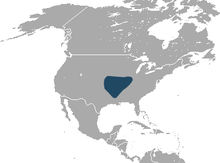Elliot's short-tailed shrew
| Elliot's short-tailed shrew | |
|---|---|
| Scientific classification | |
| Kingdom: | Animalia |
| Phylum: | Chordata |
| Class: | Mammalia |
| Order: | Eulipotyphla |
| Family: | Soricidae |
| Genus: | Blarina |
| Species: | B. hylophaga |
| Binomial name | |
|
Blarina hylophaga Elliot, 1899 |
|
 |
|
| Elliot's short-tailed shrew range | |
| Synonyms | |
|
Blarina carolinensis hylophaga |
|
Blarina carolinensis hylophaga
Elliot's short-tailed shrew (Blarina hylophaga) is a small, slate grey, short-tailed species of shrew. Its common name comes from Daniel Giraud Elliot, who first described the species in 1899.
Elliot's short-tailed shrew is similar in appearance to the closely related southern short-tailed shrew, although slightly larger on average, and was long thought to belong to the same species. It is a heavily built shrew with short legs and tail, and a long, pointed snout with long whiskers. The ears and eyes are both small, the eyelids being permanently closed in some individuals, a feature otherwise unknown among shrews.
The fur is velvety in texture, and uniformly colored greyish to brown. Adults range from 9 to 12 cm (3.5 to 4.7 in) in total length, including the 2-to-3 cm (0.79-to-1.18 in) tail, and weigh 13 to 16 g (0.46 to 0.56 oz).
Elliot's short-tailed shrew is found in lowland environments with heavy vegetation from southern Iowa and Nebraska in the north to parts of Texas and northern Louisiana in the south, including much of the states of Missouri, Kansas, Oklahoma, and Arkansas, and the northeastern corner of Colorado. Two subspecies are currently recognised:
The species inhabits a diverse range of habitats, including grasslands, agricultural land, and woodland. Although it generally prefers well watered environments with plenty of ground litter, it is also known from relatively dry and sandy terrain in Texas and Colorado, often with minimal ground cover.
Like other shrews, this species is insectivorous, its diet consisting primarily of beetles and slugs, along with other insects, spiders, and earthworms. They may also eat a small quantity of plants and fungi, and have been reported to eat North American deermice on occasion. Predators include owls, hawks, snakes, and swift foxes.
...
Wikipedia

